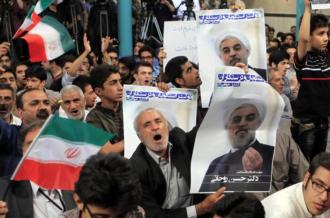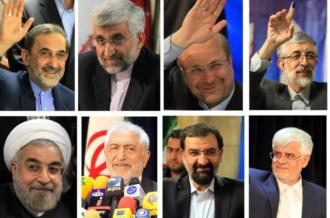Analysis: How sanctions rule Iranian politics
President Ahmadinejad is blamed for economic woes, but crushing sanctions will remain long after his departure.

For now, put aside the memory of Iran’s street protests and the YouTube images of death and violence that followed the 2009 presidential elections.
Try instead to think about what has transpired in and around Iran since then: an Arab Spring to the country’s west, international tensions over Iran’s nuclear programme, and a steady barrage of Israeli threats to bomb Iran.
All this while the leaders of the 2009 Green movement, Mir Hossein Mousavi and Mehdi Karroubi, languish under house arrest.
Oil money helped to keep things afloat in Iran. But now half of that has been annihilated by the sanctions, while transaction costs have gone through the roof. The economy was already malfunctioning, now it is in a deep malaise.
It might be surprising then, with all of that as a prelude to the upcoming June 14 elections in Iran, that national security, good governance, civil society, and foreign affairs might not be top issues on the mind of the average Iranian.
No, if Iranians turn out in numbers for this elections – and that’s a big if – there will only be one issue that all voters will hold in common; a universal truth for just about any election anywhere: It’s the economy, stupid.
“The economy is always the case with an election in Iran,” said author and journalist Hooman Majd. “It’s not unique to Iran, people have to live.”
With some estimates of nearly 40 out of 75 million Iranians surviving under the relative poverty line, living in today’s economy is proving to be more and more difficult.
Back in 2005, President Mahmoud Ahmadinejad entered onto the Iranian national stage with promises to improve the daily plight of the rural and urban poor through a series of economic policies reminiscent of the late Hugo Chavez’s economic programmes in Venezuela.
While admirable in their objectives to many observers, Ahmadinejad’s Iranian style Bolivarianism – featuring housing subsidies, cash transfers, and loans to small businesses – proved ultimately to be inefficient and detrimental to the Iranian economy.
Programmes such as Ahmadinejad’s controversial “quick returns” small business loans produced no growth, proved to be inflationary and left Iranian banks with unpaid debts.
Making matters worse, these programmes produced few new jobs.
A subsidy reform scheme that was introduced in 2010 raised the price of staples such as flour, water, petrol, and diesel and resulted in job losses as businesses faced with new economic pressures adjusted their budgets accordingly.
Sadly, for the Iranian economy, this was the economic climate before the newest rounds of European and US-led economic sanctions.
Longstanding economic woes
To be fair, a great number of problems existed with the Iranian economy before Ahmadinejad and before the latest sanctions: state-dominated enterprise, a bloated bureaucracy, a lack of economic diversification, an inefficient tax system, and a heavy reliance on petroleum exports.
 |
| Iran’s election is set for June 14 [EPA] |
But as Dariush Zahedi, director of the Berkeley Centre on Entrepreneurship and Development in the Middle East told Al Jazeera, “even if [Ahmandinejad] wanted to try, he could not have set the stage better for the sanctions bite as they did”.
The sanctions made matters worse by lessening the value of hard Iranian currency and negating any hopes that the populist economic policies of Ahmadinejad could alleviate Iranian economic woes. Moreover, with sanctions targeting the Iranian financial system, basic transaction costs skyrocketed making typically cheap imports, such as Indian rice, unaffordable for many.
The economic numbers, as a result of the sanctions and poor planning, are staggering – and will be the biggest challenge for the next president.
Inflation for the period ending in March 2013, according to the Central Bank of Iran, stood at more than 35 percent and unemployment officially was hovering at about 13 percent, although independent economists such as Mehrdad Emadi have put those figures closer to 40 percent and 20 percent respectively.
Meanwhile, data from the International Monetary Fund indicates the gross domestic product shrank nearly two percent in 2012, and 1.2 percent so far in 2013.
“Oil money helped to keep things afloat in Iran,” said Zahedi. “But now half of that has been annihilated by the sanctions while transactions costs have gone through the roof. The economy was already malfunctioning, now it is in a deep malaise.”
Inheriting a challenge
For now, former Iranian president and de facto reformist Akbar Hashemi Rafsanjani is out of the race.
Rafsanjani has been labelled a pragmatic conservative in the past for his attempts to bolster Iranian foreign trade and would have been the candidate of choice for Iran’s business elite.
Esfandiar Mashaei, Ahmadinejad’s chief of staff and bete noire of the Iranian clerical establishment, who most likely would have continued Ahmadinejad’s economic policies, is also out of the running.
Of the eight candidates who have been approved to run for president, most – such as conservative candidate and current Tehran Mayor Mohammadbaquer Qalibaf – have taken a cautious approach towards the Iranian economy and have called for expert studies on issues such as subsidy reform.
Criticism of public officials and government policies is a dangerous – and often losing – game in Iran.
This also applies to major political figures, if those criticisms approach turf marked out by Supreme Leader Ayatollah Ali Khamenei – for instance, critiques of the Iranian nuclear programme, a project under the auspices of Khamenei’s office, will most likely not be heard.
Criticising Ahmadinejad, on the other hand, has been fair game.
“The candidates, from what we see thus far, have been more likely to attribute the cause of Iran’s economic problems to Ahmadinejad and his foreign policies… They have not been shy to say that,” said Professor Gary Sick of Columbia University, who serves as director of the The Gulf/2000 Project.
It seems unlikely that protests, such as those seen for months following the 2009 election, will take place after this vote.
Iran’s leadership has done its best to ensure the upcoming election will have a high turnout, by scheduling local and national elections to coincide on the same day.
Whoever wins will have to immediately face real and serious questions about Iran’s future. After Ahmadinejad’s term is over, sanctions will still be seen in the country as the biggest impediment to economic prosperity. It follows then, that if the sanctions are the result of an untouchable nuclear programme, something, somewhere, will have to give.
 |
| Iran’s eight candidates accepted by the Guardian Council [EPA] |
Majd noted: “I think the Iranians recognise that even if they compromise, the sanctions will remain in place.”
It is only in the absurdity that is Iranian-US relations that the sanctions may not necessarily be a bad thing.
“The sanctions have other purposes, like undercutting the Israeli calls to bomb Iran,” Sick points out. “This is doubled in spades when you talk about Congress, because they despise Iran and want to show that they can do something.”
But, with 19,000 centrifuges reportedly up and running and more apparently on their way, only time will tell how this will all play out.
One thing is for sure though, after this election no-one, either in Iran or abroad, will have Mahmoud Ahmadinejad to kick around anymore.
Follow Matteen Mokalla on Twitter: @MatteenM